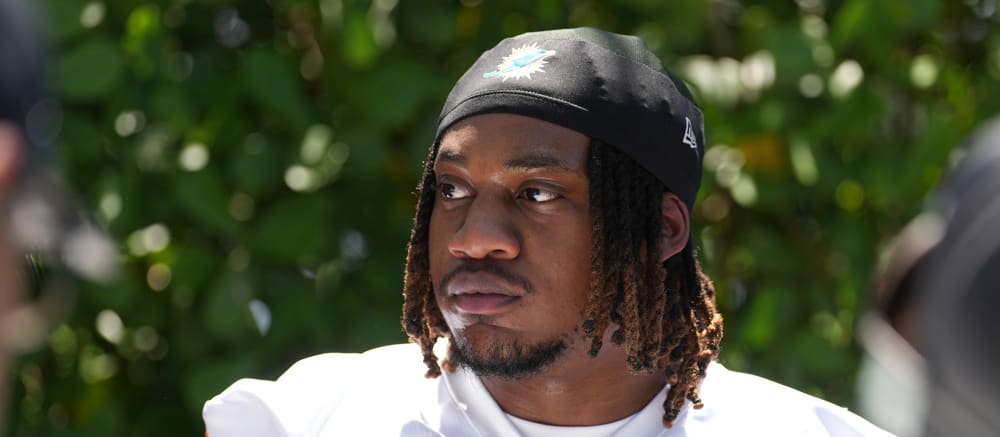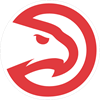This article series intends to cut through the noise of the broader prospect analysis that generally circulates through fantasy football internet media, specifically at the running back position.
More than any other, running back is one position where the evaluation is simple. Production and athletic testing win out, reliably. By focusing on production and standout athleticism you can quickly discern the general functions of a running back and the general effect they bring to the field.
This series will look only at the 2024 rookie running backs, highlighting the pertinent details in their prospect profiles and offering comparisons for how their NFL careers might unfold based on how things turned out for similar players in the past. This article will look at Jaylen Wright and Ray Davis. You can view the first article (Jonathon Brooks and Trey Benson) here and the second article (Blake Corum and MarShawn Lloyd) here.
Jaylen Wright, MIA (4th round, 120th overall)
Although Wright was never given the chance to take on major volume in the Tennessee offense, he was highly productive with the usage he did get and outproduced his fellow Tennessee running backs to a notable, clarifying extent. Wright's main selling point is his speed and his passing-down acumen, so it's odd that he fell to the fourth round of the 2024 draft in a league that ostensibly cares about speed and passing production more than ever.
Fumbling was a problem for Wright in 2022 but not
This article series intends to cut through the noise of the broader prospect analysis that generally circulates through fantasy football internet media, specifically at the running back position.
More than any other, running back is one position where the evaluation is simple. Production and athletic testing win out, reliably. By focusing on production and standout athleticism you can quickly discern the general functions of a running back and the general effect they bring to the field.
This series will look only at the 2024 rookie running backs, highlighting the pertinent details in their prospect profiles and offering comparisons for how their NFL careers might unfold based on how things turned out for similar players in the past. This article will look at Jaylen Wright and Ray Davis. You can view the first article (Jonathon Brooks and Trey Benson) here and the second article (Blake Corum and MarShawn Lloyd) here.
Jaylen Wright, MIA (4th round, 120th overall)
Although Wright was never given the chance to take on major volume in the Tennessee offense, he was highly productive with the usage he did get and outproduced his fellow Tennessee running backs to a notable, clarifying extent. Wright's main selling point is his speed and his passing-down acumen, so it's odd that he fell to the fourth round of the 2024 draft in a league that ostensibly cares about speed and passing production more than ever.
Fumbling was a problem for Wright in 2022 but not any other season, giving reason to hope that his four fumbles on 148 touches from that season was some combination of bad luck or some technique mistake that was committed only briefly. If the fumbling is more or less resolved than Wright's most glaring remaining limitation would be his vision or/and spatial processing – Wright seems to have narrow vision and seems to perceive the field as a series of one-on-one matchups rather than a full picture. Given Wright's production and given his verified standout speed, there's reason to think he can produce in the NFL even with below-average vision.
[Skill set]
Due to the previously mentioned vision limitation there are some play situations that put Wright in a difficult spot, but there aren't really any play design situations that put Wright in a difficult spot. His results as a runner between the tackles might fluctuate somewhat since Wright is liable to run himself into some difficult spots when an obvious opening isn't present, but in terms of movement ability he can probably thrive in any play design, even running with more power than you'd expect.
Indeed, Wright might be a speed back but he appears quite strong physically, and he runs with plenty of motor. Some players with processing issues are slowing down specifically because they're running with excessive caution, but that's not the issue for Wright. He's a speed back fully prepared to engage contact, which is nice to see because he has actual power at his disposal.
This strength of Wright's could additionally give him a sound passing-down projection, because he brings more pop in blitz pickup than most guys at his weight. Like his running, Wright's blitz pickup has more attitude than you'd expect of someone billed as a 'speed specialist.' The label just isn't true.
Indeed, Wright's passing-down abilities seem good enough that he could emerge as Miami's lead running back for base passing-down functions. He looks comfortable catching the ball, though Tennessee's offense generally spaced itself in a way that precluded pass-catching production out of the backfield.
[Tool set]
Wright (5-foot-11, 210 pounds) is close to a blue-chip athlete with a 4.38-second combine 40 and elite jumps (38-inch vertical, 134-inch broad jump). Wright is strong for his frame, too – his speed is applied with a notable amount of torque, meaning he can 'get fast' from hunched, squatted positions (like you might use to set anchor or set up for a cutback) just as easily as he can from a track stance. Wright's speed is not just theoretical – it's easily applied in practice, too.
You can watch how this all works in a single play: Wright's 75-yard touchdown run against Georgia in 2023.
Slot linebacker/safety Tykee Smith, who Tampa Bay drafted in the third round (89th overall), squares up Wright in the hole, about 4.5 yards away. Smith ran a 4.46-second 40-yard dash at the combine and was set up to make the play, but instead Wright crosses him up and easily leaves Smith in the dust. Because Smith had to gear up for the credible power threat posed by Wright he couldn't just wash toward a cutoff point and still have the anchor necessary to square up for contact in time, yet Wright's speed dictated that Smith give Wright that 4.5-yard cushion before breaking down. Basically, Smith couldn't get close enough to Wright to prepare a tackle motion without conceding another cutback route to Wright. The play was a certain touchdown before Wright even passed the line of scrimmage, even with a 4.46-running third-round pick more or less directly in front of him. Not many running backs have the tools to so strongly dictate a touchdown outcome so early in a play like that.
[Bottom line]
Wright has been somewhat typecast as a speed-based rotational runner, but that label might not be correct. Wright appears to me to be a three-down player who just happens to be very fast. Although Wright has not proven the ability to take on usage volume, he also never demonstrated that he can't – in terms of play design breadth Wright absolutely has the ability to stay on the field for a featured role.
The Dolphins of course have two highly-capable running backs in De'Von Achane and Raheem Mostert, so when they are healthy they will likely be clearly prioritized over Wright in terms of from-scrimmage functions. It's worth remembering, though, that Mostert and especially Achane are both very small – upwards of 20 pounds lighter than Wright – and both players have had durability issues in the NFL. Not just that, but neither of Mostert or especially Achane are well-built for pass blocking. Wright could get his foot into the door a bit, even when Mostert and Achane are both healthy, if only because Wright could establish himself as the best blitz-pickup guy of the three.
Best-case comparison: DeMarco Murray. Murray tested a little faster (4.37-second 40) at a little bit heavier of a weight (213 pounds), and later in his NFL career Murray clearly bulked up to something closer to 230 pounds, trading some speed in the process. I don't expect Wright to bulk up like Murray did, if only because Wright is two inches shorter, but the theme here has more to do with big explosiveness on big volume, both as a runner and a receiver. The reason that this is the 'best case' rather than the 'likely' comp is that it would presently require a leap of faith to project Wright withstanding such volume – the explosiveness part is easy.
Likely comparison: Lamar Miller. Miller was also a fourth-round pick for the Dolphins, but the comp here has more to do with with the height/weight/speed and skill set considerations. Miller was a quality six-year starter who probably could have done more as a runner and receiver both if he had landed on different teams throughout his career.
Ray Davis, BUF (4th round, 128th overall)
Davis' collegiate career took an improbably winding course, beginning at Temple (2019-2020) before moving on to Vanderbilt (2021-2022) and concluding at Kentucky for his final season (2023). At least in part due to a difficult childhood situation, Davis' career started late as he worked through administrative holdups. As a result he was 20 even in his first collegiate season, and now will turn 25 November of his rookie NFL season.
To me, Davis' age is irrelevant for the duration of his rookie contract. If Davis' age hurts something then it's regarding his career-earning potential, because of course his age will be cruelly held against him by the time he's a free agent four years from now. The idea that Davis' age matters for evaluating his football abilities is kind of just nonsense.
Although Davis never produced with much explosiveness at any of his three schools, that was mostly because those schools had doomed offenses to start with. Davis was a stabilizing presence wherever he went in college, and he immediately became a leading figure for each team upon his arrival. At the very least Davis showed a rugged ability to withstand volume from scrimmage, even in the face of constant obstacles. A bad luck toe ligament injury ended Davis' 2021 season in just the third game, but otherwise he held up physically while diving into the teeth of the defense over and over.
[Skill set]
In terms of from-scrimmage functions Davis' skill set is fully developed. He's a good receiver and he can execute any run design, including power. Davis' prospect profile is driven by his skill grade, which grants him the ability to contribute credibly in any run or catch situation. When you combine Davis' polish with his seeming ability to withstand major volume, you have the sum of traits to project a viable three-down starting running back.
If there's an area where Davis hasn't demonstrated as much it would have to be blitz pickup. The general theme for Davis' usage was that he'd get an extremely heavy workload from scrimmage, with most of his passing-down reps involving routes rather than blocking. It's not clear how much of this was due to potential limitations in Davis' blitz pickup versus the possibility that Kentucky just didn't really run concepts that required blitz pickup.
[Tool set]
Whereas Davis' from-scrimmage skill set is high-grade, his tools grade is something closer to average. Davis' athleticism is likely sufficient for the execution of any pertinent tasks – ie, he should prove more than functionally athletic – but he will not stand out for his movement abilities or raw power.
At 5-foot-8, 211 pounds Davis has a good natural anchor owed to his dense build, which helps him shed tacklers even without overpowering them. His 4.52-second 40 is more than good enough, and his jumps (35-inch vertical, 119-inch broad) are both at least average. While Davis' overall athleticism is probably a tad above average at best, the more worthwhile detail is that his athleticism is good enough for his particular game to translate. Davis didn't win with raw speed in college – it doesn't matter that he can't win with speed in the NFL.
[Bottom line]
It remains to be seen how the Bills choose to utilize him, but Davis is a capable contributor from scrimmage both as a runner and a receiver. There's reason to believe Davis can provide at least average efficiency on standout usage volume.
That James Cook is already in Buffalo means the Bills have no reason to take up Davis' usage potential, but (A) Davis' game is more complete than Cook, who can't take on volume as a runner due to non-viability on power concepts, and (B) if Cook were to miss any time then Davis could immediately plug in as a high-usage replacement and hold serve in the escalated role.
Best-case comparison: Frank Gore. Gore was one of those Emmitt Smith types who sort of just put up big numbers all the time, even though you couldn't really explain how in hindsight. Neither player was fast, neither player was powerful, but they sort of just had a way of falling forward and grinding their way to big plays without overpowering or running past many defenders.
Likely comparison: Jaylen Warren. Usually running backs with average tools grades don't quite reach the heights of a Gore or Smith, because their relative lack of raw athletic ability makes them volume-dependent as opposed to standout production driven by explosiveness. Warren (5-foot-8, 204 pounds) is actually a little slower than Davis at seven pounds lighter, with Warren's 4.55-second 40 trivially trailing Davis' 4.52.








































